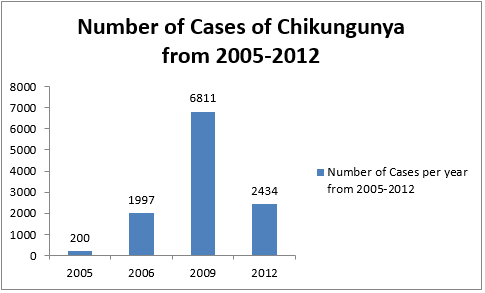Introduction
Chikungunya is a debilitating arbovirus illness caused by the Chikungunya virus. Transmission of Chikungunya occurs through the bite of female Aedes Species, both Aedes aegypti and Aedes albopictus. The incubation period for Chikungunya is from three to seven days (range: one to twelve days). Chikungunya patients usually recover within a week (3-10 days). The patient is immune to the chikungunya virus once they have recovered. The common symptoms for Chikungunya include sudden onset of fever, chills, severe headache, pain in the muscles and joints, swelling of the joints, skin rash, abdominal cramps, nausea, vomiting, sore throat, and photophobia. Pregnant women, newborn children, older people above 60 years of age, and people living in mosquito-infested regions with pre-existing medical conditions like diabetes, hypertension, or cardiovascular disease are at high risk of getting Chikungunya. There is no specific pharmaceutical drug or vaccination to cure Chikungunya. It is an illness that goes away on its own. Doctors urge patients to drink plenty of water, relax completely, and take paracetamol after the doctor’s advice to reduce fever and physical pain. In severe cases of Chikungunya, the physician carries out regular monitoring of blood pressure, provides IV fluid and electrolytes, and if required, the physician may carry out blood transfusion.
This article describes, in brief, the present status of the Chikungunya virus and the Government of India’s activities to curb the spread of the disease in India.
History of Chikungunya Virus in India
Since the early twentieth century, outbreaks of Chikungunya have been observed throughout the Indian subcontinent. West African (WA), Asian, and East Central South African (ECSA) genotypes of the Chikungunya virus have been identified. The Asian genotype was the prevalent virus in India until the 1970s.
The history of the Chikungunya virus in India is as follows:
1963: Chikungunya was first reported in India in Kolkata, West Bengal.
1964: Reports of Chikungunya outbreaks in Chennai, Pondicherry, and Vellore
1965: Chikungunya outbreaks were reported from Visakhapatnam, Kakinada, Rajahmundry and Nagpur
1973: Reported cases of Chikungunya in Barsi
2006: Re-emergence of the disease after 33 years. Many cases were reported; however, the increase in Chikungunya cases declined by 2014. During the 2005-2006 outbreak, the outbreak in India was due to ECSA genotype.
2009: 15 states in India were infected by the Chikungunya virus.
2015: Increased number of Chikungunya cases in Karnataka
2016: Increased number of Chikungunya cases in Delhi and Nearby States.
The graph below shows the incidence of Chikungunya cases in India from 2005-2012

Present status of Chikungunya Virus in India
The Chikungunya virus is endemic in 26 States and 6 Union Territories in India. In 2021 (till October 31), 82,671 clinically suspected Chikungunya cases and 8806 confirmed Chikungunya cases were reported from 22 States/UTs. In 2021, Gujarat reported the maximum number of confirmed cases numbered 2661. The other states that followed Gujarat in reporting confirmed cases of Chikungunya were Maharashtra (2,081 cases), Karnataka (1,556 cases), Rajasthan (978 cases), Kerala (423 cases), and Madhya Pradesh (303 cases). Similarly, 81,914 suspected and 12,205 confirmed cases of Chikungunya were reported from 25States/UTs during 2019.
The number of suspected and clinically confirmed cases of Chikungunya for the period 2015-2021(October 31) is given below.
However, few states/UT like Gujarat, Karnataka, Maharashtra, Telangana, Delhi, and Jharkhand have shown a higher headcount than other states in confirmed cases Chikungunya from 2015-2021. Therefore, cases in each of these states/UT during the five years are mentioned below.


The Indian Government took steps to curb the spread of Chikungunya in India
The Indian Government has carried out the following activities towards the prevention of Chikungunya in the country:
- Issued guidelines for prevention and control of Vector-Borne-Diseases.
- The National Vector-Borne Disease Control Program issued advisories to ensure the functioning of every diagnostic facility in the country with the availability of diagnostic kits.
- The Government observed “National Dengue Day” on May 8, 2020, and “Anti-Dengue Month” from June 29, 2020, to September 11, 2020, to create awareness to protect themselves from Chikungunya and Dengue.
- The Government also spread awareness through ALL India Radio to curb the growth of Chikungunya.
- The Government increased the headcount of Sentinel Surveillance Hospitals (SSHs) from 110 in 2007 to 695 in 2020 across India. The SSHs are linked with 16 Apex Referral laboratories (ARLs) with advanced diagnostic facilities for backup support for Chikungunya.
- The Indian Government provided 1,137 Chikungunya kits to SSHs and ARLs for early diagnosis and management of Chikungunya.
References
- 2020-21 Annual Report, Department of Health and Family Welfare, Ministry of Health and Family Welfare, Government of India, Pg -114. Accessed at
https://main.mohfw.gov.in/sites/default/files/Annual%20Report%202020-21%20English.pdf - Chikungunya situation in India. Accessed at
https://nvbdcp.gov.in/index4.php?lang=1&level=0&linkid=486&lid=3765 - Translational Research Consortia (TRC) for Chikungunya Virus in India (2021). Current Status of Chikungunya in India. Frontiers in microbiology, 12, 695173. https://doi.org/10.3389/fmicb.2021.695173





